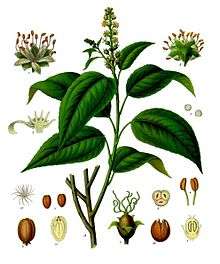Croton tiglium
Croton tiglium, known as purging croton, is a plant species in the family Euphorbiaceae. C. tiglium is also called jamaal gota in India.
| Purging croton | |
|---|---|
 | |
| Croton tiglium | |
| Scientific classification | |
| Kingdom: | Plantae |
| Clade: | Tracheophytes |
| Clade: | Angiosperms |
| Clade: | Eudicots |
| Clade: | Rosids |
| Order: | Malpighiales |
| Family: | Euphorbiaceae |
| Genus: | Croton |
| Species: | C. tiglium |
| Binomial name | |
| Croton tiglium | |
| Synonyms | |
| |
Traditional uses
Croton tiglium is one of the 50 fundamental herbs used in traditional Chinese medicine, where it has the name bā dòu (Chinese: 巴豆). C. tiglium is known as Japaala/ජාපාල or "Jayapala" in Sinhala and used in Sinhala traditional medical system of Sri Lanka and in Sanskrit. The seeds are called Jamālgoṭa in Hindi, Marathi, and Urdu, and are well-known for their toxicity (severe purgative effect). They are used to treat constipation after the seeds have undergone a traditional Ayurvedic detoxification process with cow's milk (Godugdha). This is referred to as Śodhana, a general term for detoxification.[3][4] The plant is poisonous with the bark used as an arrow poison and the seeds used to poison fish.[5]
Chemical constituents
Major known chemical constituents are crotonoleic acid,[4] glyceryl crotonate, crotonic acid , crotonic resin, and various carcinogenic phorbol derivatives.


References
- "Croton tiglium". Germplasm Resources Information Network (GRIN). Agricultural Research Service (ARS), United States Department of Agriculture (USDA). Retrieved 2008-02-19.
- Croton tiglium, theplantlist.org
- PMC4264303
- N. R. Pillai (1999). "Gastro-intestinal effects of Croton tiglium in Experimental Animals". Ancient Science of Life. 18 (3&4): 205–209. PMC 3336487. PMID 22556892.
- Croton tiglium Purdue University